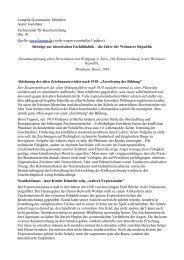Research in Visual Arts Education - The National Society for ...
Research in Visual Arts Education - The National Society for ...
Research in Visual Arts Education - The National Society for ...
Create successful ePaper yourself
Turn your PDF publications into a flip-book with our unique Google optimized e-Paper software.
BETWEEN VISUAL ARTS AND VISUAL CULTURE<br />
<strong>The</strong> future of Danish research <strong>in</strong> visual arts education<br />
As mentioned <strong>in</strong> the <strong>in</strong>troduction and <strong>in</strong> the section on the latest developments<br />
<strong>in</strong> the field of research, Danish visual arts education research is<br />
fac<strong>in</strong>g a rather complicated situation because of both the ongo<strong>in</strong>g political<br />
re<strong>for</strong>ms of the educational systems and a certa<strong>in</strong> fragmentation of the<br />
field caused by the closure of the M.A. and Ph.D. programmes <strong>in</strong> visual arts<br />
education. An outcome of this situation has been that the previously very<br />
strong connections between teach<strong>in</strong>g, teacher tra<strong>in</strong><strong>in</strong>g and research have<br />
been loosened <strong>in</strong> favour of a new and quite open perspective. Whether this<br />
situation should be considered positive or negative is hard to say due to the<br />
many unknown factors. As mentioned earlier, the latest university re<strong>for</strong>m<br />
has, with<strong>in</strong> one year, reduced the number of Danish universities from 12 to<br />
six, and DPU is now cont<strong>in</strong>u<strong>in</strong>g its activities under the much bigger University<br />
of Aarhus. Alongside with the university re<strong>for</strong>m, the “Centres <strong>for</strong><br />
Higher <strong>Education</strong>” (CVU), which were established as recently as <strong>in</strong> 2003,<br />
and which <strong>in</strong>cluded most of the <strong>for</strong>mer 18 teacher tra<strong>in</strong><strong>in</strong>g colleges, have<br />
been replaced by the new and even larger Professional University Colleges.<br />
It is still too early to say what effects these further organisational changes<br />
will have <strong>for</strong> Danish studies <strong>in</strong> visual arts education, but <strong>for</strong> sure the<br />
situation of cont<strong>in</strong>uous political and organisational pressure has <strong>in</strong>creased<br />
the difficulties with<strong>in</strong> the field. At the moment it seems probable that the<br />
research unit <strong>Visual</strong> Culture <strong>in</strong> <strong>Education</strong> will not be allowed to cont<strong>in</strong>ue<br />
its activities as an <strong>in</strong>dependent unit, although a new Assistant Professor, Pia<br />
Lundberg has been appo<strong>in</strong>ted to the unit <strong>in</strong> April 2008. Furthermore <strong>in</strong> the<br />
present situation it can be difficult to reach agreement among researchers<br />
and teacher tra<strong>in</strong>ers as to whether it is more important to develop new and<br />
broad perspectives on visual arts education such as visual culture or to fight<br />
harder <strong>for</strong> what we have, e.g. through more “traditional” <strong>in</strong>-depth studies of<br />
the benefits of visual arts education from cultural, sociological and psychological<br />
perspectives.<br />
A recent report from the Danish <strong>Arts</strong> Council (Bam<strong>for</strong>d & Qvortrup,<br />
2006) reviews art education provisions and quality with<strong>in</strong> the Danish Folkeskole<br />
<strong>in</strong> Music, <strong>Visual</strong> <strong>Arts</strong> and Handicrafts through an exam<strong>in</strong>ation of five<br />
case studies from selected schools and a content analysis of legislative changes,<br />
policy and re<strong>for</strong>ms <strong>in</strong> the area. <strong>The</strong> ma<strong>in</strong> f<strong>in</strong>d<strong>in</strong>g of the report is that<br />
while the art education provisions vary from “barely adequate” to “good”,<br />
the evaluation of the quality of arts programmes is <strong>in</strong>sufficient. In spite of<br />
these very rough generalisations based on scanty and far from homogenous<br />
material, there can be no doubt that the conclusions of the report po<strong>in</strong>t <strong>in</strong><br />
the right direction: the development towards more reflection, evaluations<br />
90 NORDIC VISUAL ARTS EDUCATION IN TRANSITION



